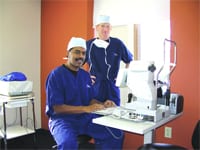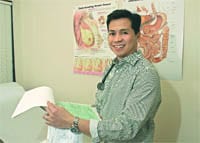Vision to Succeed Eye & Lasik Center Stays Current in a Rapidly Changing Field
To Dr. John Warren, becoming an eye doctor was a decision that just added up.
“I was always and big science and math guy, dating back to grade school,” he said, but was initially unsure of how to turn that into a career. “When I was in college, I did a lot of science and research, but I felt like it was too far removed from the real world.”
The broad field of medicine, however, was anything but, and it began to capture his attention.
“I thought medicine bridged science and the real world,” Warren said. “I felt like medical care had a strong scientific backbone to it. And I picked ophthalmology for a similar reason. I like the fact that it has a strong math and science foundation to it; with optics and ocular anatomy, you have to be decent with numbers, and that drew me to ophthalmology.”
Dr. Pierre Alfred saw the light, so to speak, in a different way. He was in the military, working as a hospital foreman and looking for something to do with his life, when he was presented with several opportunities in technical fields.
“ I chose ocular technology,” he told The Healthcare News. “I soon realized this was my calling in life, and I certainly haven’t regretted it; I’ve found it to be a wonderful career path.”
The two would eventually become partners at Eye & Lasik Center, which began as the Greenfield Eye Center 30 years ago. Alfred bought out the practice’s original owner in the late 1990s, and Warren came on board five years ago. Today, they have a strong presence in Franklin County, with locations in Greenfield, Shelburne, and Athol, as well as one in West Springfield.
“It’s changed a fair bit over the years,” Warren said, “but it’s been a multi-location practice throughout its history. We think of ourselves as an expanding eye-care group, and we’re in good locations; we draw patients from Southern Vermont and Southern New Hampshire as well as communities in this area. We’ve typically had a pretty good reach.”
With five optometrists and a third doctor who came on board just three months ago, Dr. Louis Verstringhe, Eye & Lasik Center continues to grow. This month, the three doctors talked with The Healthcare News about how eye care, and particularly eye surgery, has changed over the years, and why the field remains as exciting to them as when they first chose it.
Laser Precision
Warren said he enjoys the independent nature of ophthalmology.
“We get to diagnose and treat the patient, and we don’t have to refer the patient to other providers,” he explained. “When they come to us with a problem, we make the diagnosis and provide the treatment ourselves. It’s self-contained in that way. And, of course, being able to restore sight is phenomenal. It’s a tremendous responsibility, and really rewarding.
“The concept here has always been to try to be a full-service eye-care facility, so we do both primary eye care and advanced surgical eye care,” he continued. “We do routine eye exams and contact lenses and glasses, but we also offer modern eye surgery, LASIK, cataract surgery, and laser surgery for glaucoma.”
LASIK is celebrating the 15th anniversary of its initial approval by the U.S. Food and Drug Administration, but it’s been far from a static 15 years, Warren added.
“Even within the field of LASIK or refractive surgery, the laser technology has improved periodically,” he said. “There are always new instruments being developed, and the laser gets faster and more efficient, so surgical time gets shorter, which improves patient safety and reduces recovery time. Even though each advance has been small, they add up to safer, more effective care.”
Then there’s laser surgery for glaucoma, which isn’t exactly new either, Warren said, but has really taken off with patients who previously required daily eyedrop treatment. “Now their glaucoma is successfully managed with an in-office laser procedure. It’s very exciting.”
Perhaps the most intriguing recent development in eye surgery, however, involves treatment of cataracts (see story, page 16). Today’s lens implants can not only reverse the effects of cataracts, but actually restore a patient’s vision to where it was before he or she needed glasses or contact lenses.
“Patients are either pleasantly surprised or really impressed with what lens-implant technology can do,” Warren said. “Typically, a patient having cataract surgery already has compromised vision before the cataract, so removing the cataracts plus allowing them to see without glasses is pretty amazing.”
That’s a gratifying experience for the doctors and optometrists, Alfred said.
“The absolute best part of this job is the patient interaction, the fact that I’m making a very significant impact on people’s lives visually, and that, every time, I’m helping them cope with their illness or providing them with sight they thought they had lost,” he said. “That interaction is truly wonderful. The other part is the intellectual challenge of being able to deliver the things we currently do. It’s interesting and very stimulating.”
Eye to Eye
That’s a major plus for Verstringhe as well.
“We have the ability to see a change in the eye and see improvement, to be able to visualize the disease process and watch it improve,” he said. “And the most rewarding part is giving people their vision back; that’s the ultimate – to hear what they want to do with their lives and restore that ability back to them.”
Verstringhe, who came to Massachusetts from a practice in Texas, said he recognized right away that Warren and Alfred were doctors he wanted to work with.
“My partners are great,” he said. “You have to be sure you agree with their style of interacting with patients, and that they have the type of personality where you want to work alongside them,” he told The Healthcare News. “You want to see eye to eye with them.”
Even though he’s been in the field for a shorter time, Verstringhe appreciates the challenges that modern technology allows doctors to tackle in the office.
“It’s nice to see improvement, to look at the pathology and strive to resolve the issue,” he said. “There are some conditions that are pretty stubborn in our field, and it’s satisfying to watch them improve.”
Warren said that, despite the advances in eye care that offer radical improvement to patients, too many people still put off seeing an ophthalmologist when their vision declines, but, as with most medical conditions, it’s better to see a doctor earlier than later.
“It’s human nature to put these things off,” he said, “but we recommend to all our patients a routine, preventative eye-care schedule. You’d hear that from any medical provider — you’ll do best if you stay on top of blood pressure and cholesterol, for instance; if you make those diagnoses early and treat those things in a timely fashion, you’re less likely to run into complications.
“Well, if you make the diagnosis for glaucoma in the early stage, the prognosis is excellent,” he continued, “but if you wait until a patient is having symptoms, it’s much more difficult to manage, and vision loss is harder to prevent. So routine eye care, having a proactive approach to preserving vision, is a far better strategy.”
Alfred said it can be challenging to keep up with the advances in eye surgery, but it’s necessary.
“The technologies are just getting better and better,” he said. “They’re terrific now, and I see nothing but good things in the future. It does take some effort to stay on the cutting edge, but that’s what we’ve done over the years. You have to have a lot of enthusiasm to do that. But we’re changing people’s lives, and that’s extremely gratifying.”



Comments are closed.